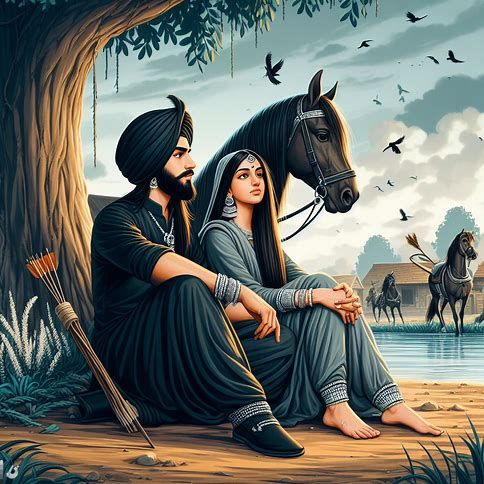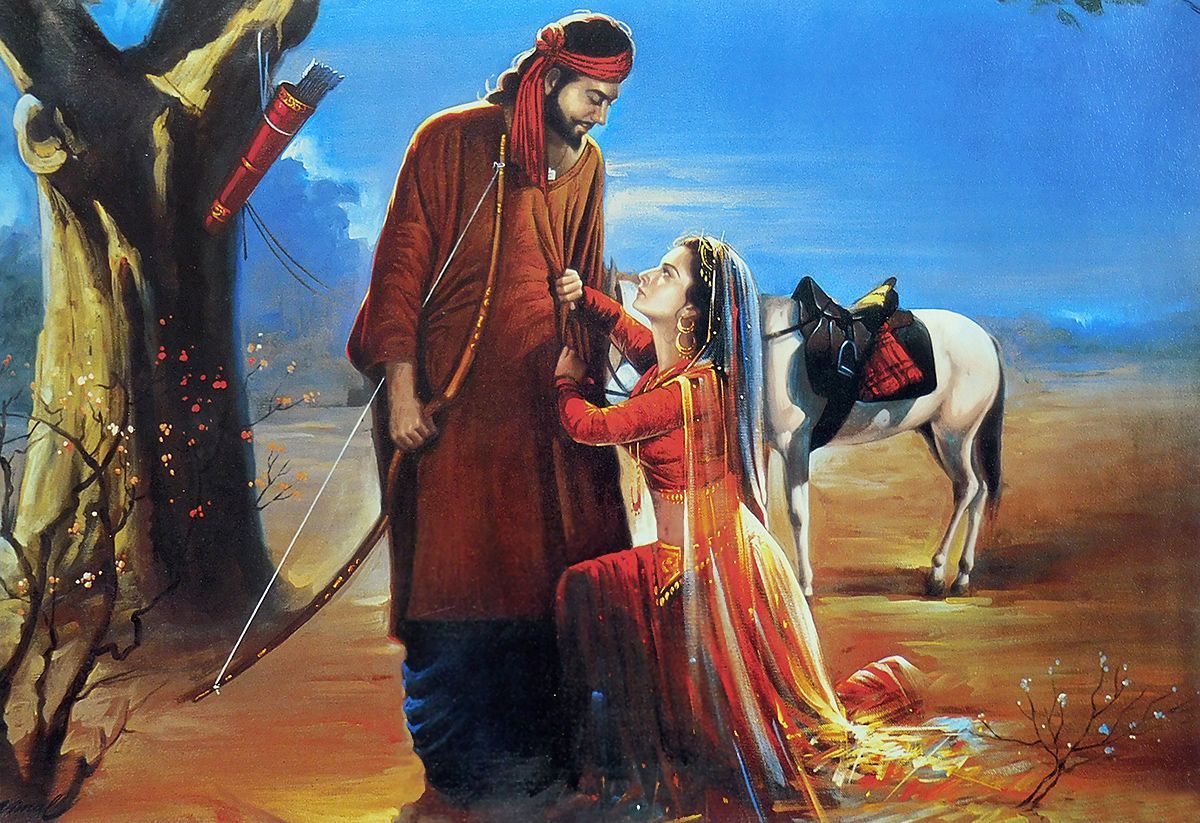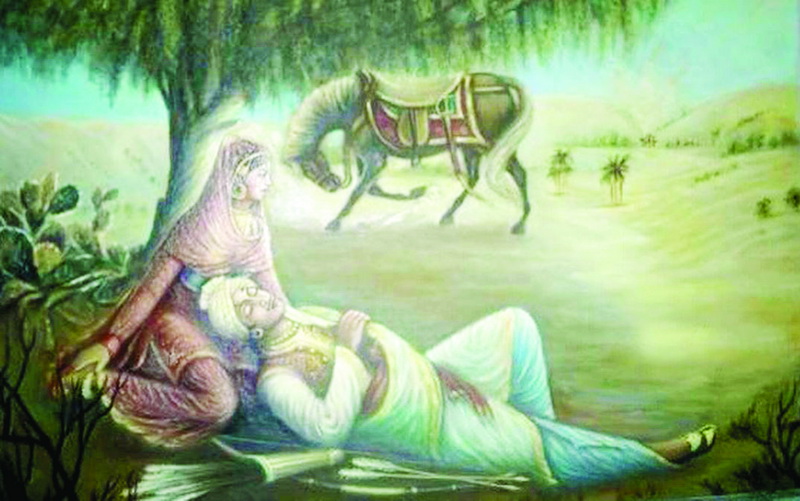Story of Mirza Sahiban
The Tragic Love Story in Punjab

Story of Mirza Sahiban is a tragic love story particularly from Punjab in Pakistan.
Like any other love tragedies, this tale has been passed down through generations, which was about the forbidden love, family honor, and leading to the tragic destiny.
The Story Context of Mirza Sahiban
Historians generally place the events of this tale in the 17th century (1600s AD), during the mid part of the Mughal era.
The story is believed to have originated in the Punjab region, specifically in the area that now is neara Jaranwala & Jhang.
While some historians debate the historical authenticity of the characters, most agree that the tale is based on real events that later got transferred through oral traditions.
Dr. Tahir Mahmood, a prominent Pakistani folklorist, suggests that the story reflects the social dynamics and tribal customs of medieval Punjab, particularly the concepts of honor, family loyalty, and arranged marriages.
The Early Years of Mirza & Sahiban
Mirza was born into a Kharal Jatt family in the village of Danabad, near Jaranwala (in present-day Pakistan).
His father, Vanjhal Khan, was a respected chieftain known for his bravery and horsemanship.
From an early age, Mirza showed exceptional skill in archery and horseback riding, following in his father's footsteps.
Sahiban was born to a Sial family in Khewa (modern-day Khewa Shareef in Pakistan).
Her father, Khewa Khan, was a powerful landlord.
The Sials were known for their pride and strict adherence to tribal customs.
Sahiban was blessed with extraordinary beauty and intelligence.
But these traits later proved to be counter productive in this tragic tale.
Education and First Meeting
In keeping with the tradition of the time, both Mirza and Sahiban were sent to study at a local madrassa (religious school). It was there that their paths first crossed.
The madrassa was run by a respected teacher who taught both boys and girls from noble families.
During their time at the madrassa, Mirza and Sahiban developed a deep friendship that gradually blossomed into love.
They often stole glances at each other during lessons and exchanged notes through their friends.
Their innocent love grew stronger with each passing day, despite the strict social norms that forbade such relationships.
The Growing Love between Mirza & Sahiban

As they grew older, their love deepened.
Mirza often rode his famous horse, Bakki, to meet Sahiban secretly.
They used to meet in the fields of mustard flowers, away from the prying eyes of society.
Their meetings were brief but intense, filled with promises of eternal love and dreams of a future together.
Sahiban's beauty was legendary, and many powerful families sought her hand in marriage.
However, her heart belonged only to Mirza. They exchanged promises to marry each other, knowing well the consequences their love might bring upon them.
The Crisis
The turning point in their story came when Sahiban's family arranged her marriage to a man from another powerful family.
When Sahiban learned of this, she secretly sent a message to Mirza, asking him to rescue her before the wedding.
Mirza, true to his reputation as a skilled horseman, rode to Khewa on his beloved horse Bakki.
He arrived on the day before Sahiban's wedding and helped her escape.
This act of defiance against tribal customs set in motion a chain of events leading to their tragic end.
The Fateful Journey
As they fled on Bakki, Sahiban's brothers and other family members pursued them.
Mirza, confident in his archery skills and the speed of his horse, was certain they could escape.
However, the story takes a dramatic turn here.
According to the legend, when they stopped to rest under a jal tree, Mirza decided to take on their pursuers with his bow and arrows.
Sahiban, knowing her beloved's exceptional archery skills would result in the death of her brothers, made a crucial decision.
While Mirza slept, she broke his arrows and hid his bow in the thick branches of the tree.
The Tragic End
When the pursuers caught up, Mirza found himself without his weapons.
Despite his bravery in hand-to-hand combat, he was overwhelmed by numbers and killed.
Sahiban, unable to bear the sight of her lover's death and unwilling to return to a life without him, took her own life.
Historical Perspectives on the Story of Mirza Sahiban

Historians and scholars have analyzed this tale from various angles.
Some see it as a commentary on the rigid social structures of medieval Punjab, while others interpret it as a critique of the honor-based tribal system.
Dr. Fauzia Saeed, a Pakistani anthropologist, argues that the tale reflects the complex relationship between individual desire and societal expectations in South Asian culture.
She points out how the story challenges traditional gender roles, with Sahiban making the ultimate decision that leads to their fate.
Other historians, like Dr. Mubarak Ali, suggest that the tale serves as a warning against defying social norms and family honor.
However, he also notes that the enduring popularity of the story indicates a deep-seated resistance to oppressive social customs.
Literary Impact
The story of Mirza Sahiban has inspired countless poems, songs, and theatrical performances across South Asia.
The most famous version is the poem written by Peelu, a Punjabi poet who immortalized the tale in verse.
His work has been translated into multiple languages and continues to be performed in various folk traditions.
Modern Interpretations
Modern scholars often interpret the tale as a feminist narrative, focusing on Sahiban's agency in determining the outcome.
Her decision to break Mirza's arrows is seen not as betrayal but as an attempt to prevent bloodshed between her lover and her brothers.
Dr. Ayesha Jalal, a prominent historian, suggests that the tale represents the eternal conflict between love and duty, individual desire and social responsibility.
She argues that Sahiban's actions demonstrate the complex moral choices women often face in patriarchal societies.
Cultural Significance
The tale of Mirza Sahiban remains deeply embedded in Punjab's cultural consciousness.
The locations mentioned in the story have become cultural landmarks, and annual festivals celebrate the lovers' memory.
The story is often referenced in contemporary literature, music, and film, demonstrating its continued relevance to modern audiences.
Lessons and Legacy
The tragic tale of Mirza Sahiban continues to live on with audiences for several reasons:
1. It highlights the conflict between individual freedom and societal constraints
2. It explores the complex nature of love, loyalty, and family honor
3. It raises questions about gender roles especially the females in our society
4. It serves as a critique of rigid social structures and traditions
Wrap Up
The story of Mirza Sahiban remains one of the most powerful expressions of tragic love in South Asian folklore.
While historians may debate the historical accuracy of specific details, the tale's emotional truth and social commentary continue to speak to contemporary audiences.
The legend serves as a mirror to society, reflecting both the beauty of pure love and the tragic consequences of social restrictions.
Whether viewed as a cautionary tale or a celebration of love's power to challenge social norms, the story of Mirza Sahiban continues to captivate audiences and inspire new interpretations.
The story remains a vital part of Punjab's cultural heritage and a powerful reminder of love's transformative, and sometimes destructive power.
You may also read the Story of Mirza Sahiban at Wikipedia